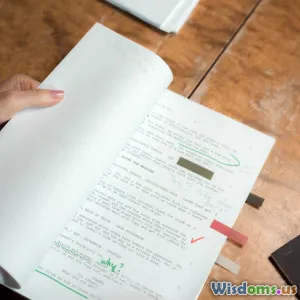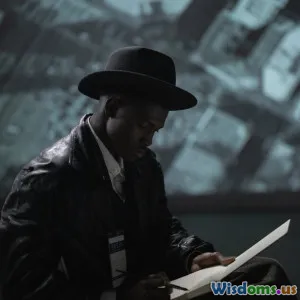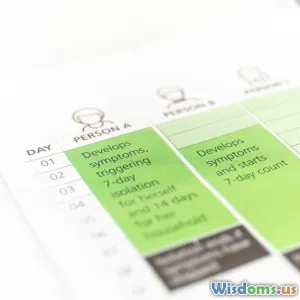
Rewrite Your First Paragraph and Transform Your Story
9 min read Discover how rewriting your first paragraph can redefine your entire story and captivate readers from the start. (0 Reviews)
Rewrite Your First Paragraph and Transform Your Story
Great stories hook readers from the very first sentence. But what if you find your opening paragraph falling flat? Rewriting your first paragraph doesn't just polish your prose; it can redefine the entire narrative, giving your story fresh energy and coherence. This article dives deep into why your first paragraph holds such magnitude, practical strategies to revise it effectively, and how this key change can transform your entire story.
Introduction: Why the First Paragraph Matters More Than You Think
The opening paragraph of any story is its handshake with the reader — a first impression that either invites or repels. Literary theorist Jane Friedman emphasizes, "The first paragraph sets the tone, promises the story’s trajectory, and showcases your unique voice."
Studies show that readers often decide within the first 50 words whether to continue reading. This statistical reality means the first paragraph's clarity, intrigue, and emotional pull are paramount. Consider the iconic opening to George Orwell's "1984":
"It was a bright cold day in April, and the clocks were striking thirteen."
This single sentence immediately evokes unease and curiosity, setting a dystopian tone. But many budding writers struggle to capture such potent introductions. The good news is rewriting that first paragraph can breathe new life into fledgling narratives and retune reader expectations.
The Power of the First Paragraph: Setting Expectations
Your first paragraph doesn’t just introduce the story. It establishes its rhythm, sets stakes, and invites empathy or exhilaration. More than a formality, it serves critical roles:
1. Establishes Scene and Setting
A well-crafted opener places readers right at the heart of the narrative’s world — whether it’s a bustling cityscape or a quiet farmhouse. For example, Walker Percy's "The Moviegoer" starts with:
"Every once in a while I try the works of some French philosopher to raise my spirits."
This line sets a reflective, philosophical tone and subtly hints at the protagonist’s mindset and milieu.
2. Introduces Voice and Style
A distinctive voice perseveres throughout a story and hooks readers emotionally. The first paragraph reveals this voice clearly. Zadie Smith’s novel "White Teeth" opens with humor and insight, showcasing her style:
"Early in the morning, on the tennis courts at Windrush, Samad runs into a skeleton."
The unexpected mention stokes curiosity with wit and mystery.
3. Creates Immediate Conflict or Curiosity
Suspense, surprise, or intrigue in the first paragraph reels readers in fast. Look at the gritty start of Raymond Carver’s "Cathedral":
"This blind man, an old friend of my wife’s, he was on his way to spend the night."
Intrigue about the blind man unfolds tension right away.
How to Rewrite Your First Paragraph Effectively
Redrafting your opening is both an art and a craft. Here are structured steps to do it effectively:
A. Review Your Story’s Core Message
Before attempting edits, clarify what your story fundamentally communicates. Are you telling a tale of transformation, loss, love, or revenge? Your first paragraph should engage with the central theme to resonate instantly.
B. Highlight the Most Compelling Element
Identify what intrigues you most—an unusual setting, a character’s unique trait, or a looming conflict—and feature it upfront.
Example:
A fantasy story with a protagonist hidden among humans might begin with:
"The dragon slept beneath the city’s subways, unheard but ever watchful."
This approach plants curiosity about dragons and the setting immediately.
C. Use Vivid, Specific Details
Evoking sensory imagery evokes stronger emotional impact. Instead of "It was a dark night," consider "Fog wrapped the streetlamps like ghostly veils on a moonless night." Such specificity lures readers deeper into the world.
D. Experiment with Point of View
Sometimes, changing the narrative viewpoint in the first paragraph energizes your story. Shifting from third-person omniscient to first-person intimacy can create connection:
Original:
"The town was quiet."
Revised:
"I never liked how quiet this town felt, as if secrets lurked beneath the silence."
E. Balance Clarity and Mystery
Striking the right amount of intrigue is key. Too much vagueness frustrates; too much clarity bores. Use precise language but hint at larger questions.
F. Seek Feedback and Revise Repeatedly
Sometimes, it takes several iterations and feedback rounds to craft an opening that truly transforms your story's impact. Consider workshops, beta readers, or professional editors.
Real World Insights: Transformations Through the First Paragraph
Several well-known authors recount how rewriting their openings invigorated their entire manuscripts.
-
Stephen King, in his memoir "On Writing," credits improvements to his first paragraphs for boosting narrative suspense.
-
Chimamanda Ngozi Adichie, author of "Half of a Yellow Sun," revised her opening multiple times to ensure the immediate voice of her narrator was authentic and gripping.
Each rewrite sharpened the emotional clarity and engagement from the start.
Benefits of Rewriting Your First Paragraph
Revising your first paragraph yields notable advantages:
-
Boosts Reader Retention: Studies find readers continue with the story when hooked immediately.
-
Elevates Writer Confidence: A strong start propels further writing with momentum.
-
Sharpened Narrative Focus: Reworking your opening often clarifies story priorities.
-
Enhanced Marketability: Catchy, polished openings improve chances with agents and publishers.
Common Pitfalls When Rewriting
Avoid these mistakes:
-
Overloading Information: Don’t cram your first paragraph with too much backstory.
-
Starting Too Slowly: Skip generic descriptions and get to the meat quickly.
-
Ignoring Reader Expectations: If your genre is thriller, promise tension immediately.
-
Sacrificing Style for Clarity: Balance readability with your unique voice.
Action Steps to Transform Your Story Today
- Identify your current first paragraph and read it aloud. What emotions or images does it evoke?
- Write down what excites you most about your story. Madden that element upfront.
- Draft three alternate first paragraphs with different tones, viewpoints, or openings.
- Seek peer feedback focusing specifically on the opening’s impact.
- Choose the strongest paragraph or combine elements.
- Integrate the revised paragraph and read the entire story for flow.
Conclusion: The Doorway to Your Story’s Heart
Your first paragraph is more than just introductory words; it’s the gateway that determines your story’s destiny. By committing time and care to rewriting it, you reclaim control over how readers engage, interpret, and emotionally invest. Whether you aim to stir emotions, build suspense, or vividly paint your world, transforming this initial section can reshape the entire narrative arc. Embrace the rewrite — your story’s potential depends on it.
Start today. Rewrite your first paragraph with intention, passion, and focus. Watch as that change ripples throughout your whole story, captivating readers from start to finish.
Rate the Post
User Reviews
Popular Posts





















